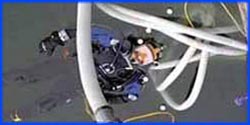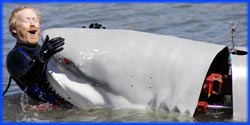


Premier Date: April 29, 2009
confirmed
Adam and Jamie started with 30,000 paper safety matches and cut the heads off, collecting them in a 1-US-gallon (3.8 L) bucket. When these were ignited with a slow-burning fuse, they generated a fireball approximately 10 feet (3 m) high, confirming the myth. However, the person who submitted it had also asked what would happen if 1,000,000 heads were used, so the entire crew spent a day cutting off match heads to fill a 44-US-gallon (170 L) drum. These were then ignited to create an intensely bright, 50-foot (15 m) fireball. Finally, Adam and Jamie built an improvised cannon out of a K-size argon cylinder and loaded it with 60,000 match heads, using a 6-pound (2.7 kg) bowling ball as the projectile. They aimed it at a rack of bowling pins and set it off, but the ball never hit the pins; instead, it skipped off the ground, sailed over them, and then flew 1,500 feet (460 m) uphill. Adam commented afterward that the cannon might have propelled the ball some 3,000 feet (910 m) on level ground.
busted
Grant, Tory, and Kari investigated this myth in three parts: the number of bricks needed for a 7-foot (2 m) diameter ball, whether its weight would make it hard to push around, and whether it would damage a car after rolling downhill. They managed to collect half a million bricks, and calculated that a ball consisting of 5 million bricks would weigh 10 tonnes (22,000 lb), much too heavy for people to push unassisted. After borrowing another half a million bricks from a private collector, the Build Team brought in every available crew member to put together a 7-foot ball weighing 3,000 pounds (1,400 kg). Lastly, they found a road on which to roll the ball safely, set up an alley made of construction barricades, put a car at the bottom, and let the ball go; however, it crumbled into pieces long before reaching the car. All three parts of the myth were declared busted, and the Build Team conjectured that the people in the video may have used a large, hollow sphere as the core of their Lego ball, and glued the pieces to it. This would have made the Lego sphere far easier to push and far less likely to break up or damage a car on impact.
busted
Adam and Jamie found a high-performance car and set it up to run in place, with only one tire spinning in contact with the ground. In the first test, Jamie revved the engine to top speed, causing the tire to emit thick smoke and eventually burst. No flames were observed at the time; however, after a lunch break, they discovered that some of the rubber particles had smoldered and built up enough heat to ignite. Believing that a spark might be needed to get the tire to burn, Adam set up an angle grinder and turned it on as Jamie stepped on the gas pedal for the second test. The tire did not blow out or burn this time, so for the third test, Adam hooked up a container to leak gasoline onto the tire as it spun and the grinder threw sparks. Again there was no fire, and Jamie theorized that the air turbulence caused by the spinning tire was preventing the gasoline from igniting. With no flames generated during any test, Adam and Jamie declared the myth busted.
busted
Tory built the homemade speakers according to the myth’s specifications and created his own surround sound setup, but when he turned on the music, the speakers didn’t work. Thinking that there might not be enough electricity to power all the speakers at once, Tory used only a single speaker but failed to get any sound again. The homemade speakers clearly did not work, and Tory also pointed out that the claim that these homemade speakers cost less than one dollar each was not true. A single mini jack alone costs around ten dollars, and Tory’s entire homemade surround sound set cost one hundred fifty dollars to build.
Previous: Episode 116: Banana Slip/Double Dip